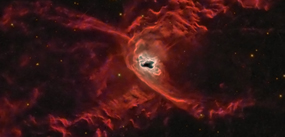Syllabus
Download & Print [pdf]
ASTRONOMY 353
Astrophysics: From Black Holes to the First Stars
Unique No. 48005, Spring 2013
CLASS MEETS: TTh 12:30-2pm in RLM 15.216B
INSTRUCTOR: Prof. Volker Bromm
Office: RLM 16.214
Phone: 512-471-3432
Email: vbromm@astro.as.utexas.edu
Office Hours:
COURSE WEBSITE:
https://www.as.utexas.edu/astronomy/education/spring13/bromm/353.html
TEACHING ASSISTANT: Aaron Smith
Office: RLM 15.203
Phone: 512-232-3958
Email: asmith@astro.as.utexas.edu
Office Hours:
Recitation Sections: Tues., 6 PM, RLM 15.216B
COURSE OBJECTIVES: We will cover the exciting phenomena happening at the end of a star's life: supernova explosions and gamma-ray bursts, and the formation and properties of compact remnants (white dwarfs, neutron stars, and black holes). This will lead us to topics at the current frontier of astrophysics. You will learn to look at the physics behind these cutting-edge phenomena, and make things as simple as possible, but still capture the important effects.
TEXTS:
There is no required text that you have to buy. But there are some optional books that you may find useful. Those will be placed on reserve in the PMA (RLM 4th floor) library. To cover the course material, we will provide you with detailed lecture notes, available to you for downloading from the course website.
The optional texts are:
- A.C. Phillips: "The Physics of Stars" (2nd edition), Wiley
- Dan Maoz: "Astrophysics in a Nutshell", Princeton University Press
- Oyvind Gron/Arne Naess: "Einstein's Theory" (Springer)
GRADING: Your final grade will be based on a point system:
|
In-class Quizzes |
10 |
|
|
2x15 |
|
Homework |
40 |
|
2 Group Projects |
20 |
We won't have a Final Exam.
The following grading scheme will be used:
|
A |
= |
89 |
- |
100 |
|
A- |
= |
85 |
- |
88 |
|
B+ |
= |
82 |
- |
84 |
|
B |
= |
72 |
- |
81 |
|
B- |
= |
72 |
- |
81 |
|
C+ |
= |
68 |
- |
69 |
|
C |
= |
68 |
- |
69 |
|
C- |
= |
60 |
- |
61 |
|
D |
= |
50 |
- |
59 |
Any score below 50 is failing (F).
HOMEWORK AND GROUP PROJECTS:
The smaller problem sets and the two more extended group projects will
contain analytical and numerical parts. I assume that you know one
high-level language (C, Fortran, IDL, Mathematica, ...), enabling
you to solve problems numerically. Please ask if you feel you need
to catch up on your computer literacy. We will be glad to suggest
ways to quickly get up to speed if necessary.
QUIZZES: We will have frequent in-class, unannounced quizzes, where you will work with 1 or 2 of your colleagues to solve small problems (with a duration of about 10 mins each). The quizzes will not test your memory by asking you to remember some fact or another. Instead, the quizzes will often ask you to devise an "order-of-magnitude" (back-of-the-envelope) solution to a problem based on the material that we have introduced in class.
Quantitative Reasoning (QR) FLAG:
This course carries the Quantitative Reasoning flag. Quantitative Reasoning
courses are designed to equip you with skills that are necessary for understanding
the types of quantitative arguments you will regularly encounter in your adult and
professional life. You should therefore expect a substantial portion of your grade
to come from your use of quantitative skills to analyze real-world problems.
COURSE AND UNIVERSITY POLICIES:
- CLASS ATTENDANCE:
It is important that you come to class. You will not be successful
otherwise in following the course material. In addition, we will
have unannounced quizzes. If you miss one, there will be no make-up
quiz. But you are allowed to miss up to 2 quizzes without penalty;
make sure to talk to me if you have to be absent from class more
than 2 times, so that we can discuss your situation.
- EXAMS: There will be no final exam. Instead, we will have two in-class exams, covering 1/2 of the course material each.
There will be make-up exams ONLY for students with valid excuses.
- PLAGIARISM: Scholastic dishonesty, in particular any plagiarism, will be
prosecuted in accordance with the university guidelines. In simplest terms,
plagiarism occurs if you represent as your own work any material that was
obtained from another source, regardless how or where you acquired it.
Please have a look at:
http://deanofstudents.utexas.edu/sjs/scholdis_plagiarism.php
There, you find a more detailed description of what constitutes plagiarism in its various forms. In particular, have a careful look at "paraphrasing".
- RELIGIOUS HOLIDAYS: University policy is to respect religious holidays. If you have to miss a lecture or exam because of a religious holiday, you will not be penalized. But you need to tell me ahead of time.
- NOTICE: Students with disabilities may request appropriate academic accommodations from the Division of Diversity and Community Engagement, Services for Students with Disabilities, 471-6259.
COURSE CONTENT:
- Introduction
- Basic Physics of Compact Objects
- Stellar Evolution: Brief Overview
- White Dwarfs
- General Relativity I: Spacetime and Geodesics
- General Relativity II: Field Equation
- Neutron Stars
- Black Holes
- Hawking Radiation
- Supernova Explosions
- The First Stars in the Universe
- Epilogue: The Cosmic Frontier

The Red Spider Planetary Nebula
[C. Milovic/NASA]
Professor
RLM 16.214 · (512) 471-3432 · email
Office Hours
TBA
TA
Aaron Smith
Review Sessions:
Tues., 6 PM, RLM 15.216B